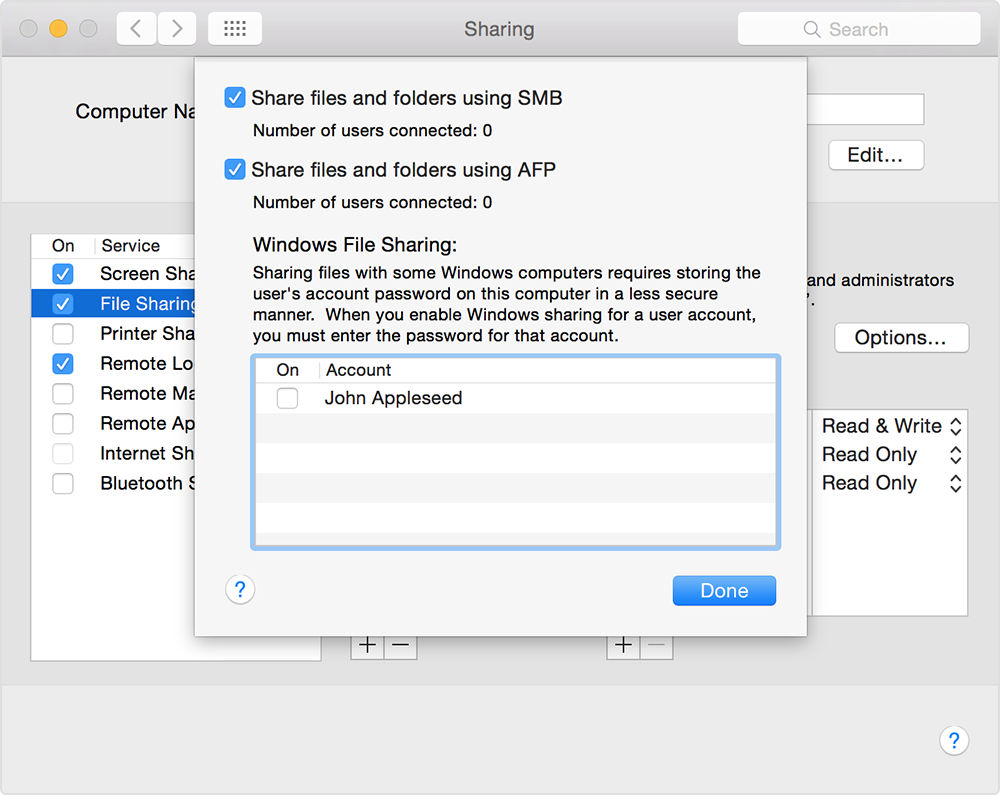
- Windows mac file sharing mac os x#
- Windows mac file sharing mac os#
- Windows mac file sharing full#
- Windows mac file sharing software#
- Windows mac file sharing mac#
If you're having trouble copying large files or any files to a Windows share you can often copy the files using the Terminal with RSYNC or the CP command. The following characters are not allowed in Windows file names and there’s a 31 character file name length limitation.
Windows mac file sharing mac#
Some characters that are allowed in file name on the Mac aren't allowed in file names in Windows.

There's a couple of limitations when using AFP. The workaround and recommended solution is to use Group Logic's ExtremeZIP.ĪFP/Windows Character and File Name Limitations After contacting Microsoft support on the issue they confirmed it would not work due to the quoted issue above.
Windows mac file sharing mac os#
This same issue is apparent in Mac OS 10.6 with recent experience and none of our numerous attempted workarounds were sufficient. And in turn does not work with Win2008 Clustered file shares. With MAC OS 10.5 there appears to be a change to the client where it only tries the IP Address, and never tries the NetBIOS name or FQDN. With MAC OS 10.4 we've seen it work correctly with Win2008 Clustered file shares. In order to make the connection you need to connect to the share name associated with the cluster file share server name. In Win2008 Failover Clustering we introduced a new Share Scoping feature, where shares are only available under the clustered name instance they are associated with. "Send LM & NTLM - use NTLMv2 session security if negotiated"įrom: Macintosh 10.x client cannot connect to File Server on Windows 2008 Failover Cluster Microsoft network server: Digitally sign communications (always) set to disabled Microsoft network client: Digitally sign communications (always) set to disabled Resolutions Windows 2003/2008/Vista/7 Adjustments - Disabling SMB Signing I've seen only sporadic issues with this and should be resolved for 10.5 and 10.6 as I've just tested with NTLMv2 only enabled. Do the following to lighten the server's security settings. Macs (prior to 10.58 "Leopard") and some earlier versions of Windows do not support this. 2008 Servers ship with the default security setting of "Send NTLMv2 response only" (2008 R2 comes with this setting "not defined" before and after promotion to a DC). With Windows Server 2008 new security lock downs have produced new connectivity/authenticatio n issues with Mac and some Windows machines.
Windows mac file sharing full#
In this case you may have "simple file sharing" enabled preventing enabling of Full Control for Everyone within the share permissions (not the security permissions). Similarly, if you're not seeing all of your file shares when browsing a share on a Windows XP computer you may not be able to see all the files and folders (particularly within the Documents and Settings folder). See the "Adding the SMB Port to Connection String" for 10.5 and 10.6 below. There's a simple workaround but can cause problems to those of you who browse to your servers or shares using the network browser in the Finder.
Windows mac file sharing mac os x#
This has something to do with the port usage in Samba on the Mac OS X side and may or may not be resolved by upcoming patches in 10.5 and 10.6. Alternately, you may have very slow logins. This also causes 10.6 machines to not be able to copy larger files to the server.

Mac OS 10.5 may actually authenticate and list files but have read-only access to the server.Īnother known issue that occurs after authentication is is not being able to see all of your folders, or none of your folders, when connected to a Windows share. The symptoms are different in 10.5 and 10.6 where 10.6 can actually copy small files to the server using the Finder but when trying to copy larger files the Finder acts like the copy finishes then leaves a 0kb file on the server.
Windows mac file sharing software#
This disconnect is attributed to SMB signing.Īlternately, in Mac OS 10.5 or 10.6 you may have issues saving files to the server after you've authenticated (some of these issues may have been or will be resolved by Apple OS Software Updates). All the hassle is actually an easy fix on both 20. After entering your credentials you’ll receive an error saying something along the lines of “server could not be found,” when clearly it’s there because it asked you to authenticate. When this is the case a Mac running Tiger (10.4.x) or below will not be able to authenticate to a Windows server.

Whereas, your 10.4 clients can connect without an issue.ĭomain controllers by default are enabled to “Digitally Sign Communications” always for network clients and servers (prior to a server being promoted to a DC this setting will be disabled. Your file server is part of a Windows 2008 Cluster and your 10.5 and 10.6 machines are unable to connect to shares.


 0 kommentar(er)
0 kommentar(er)
